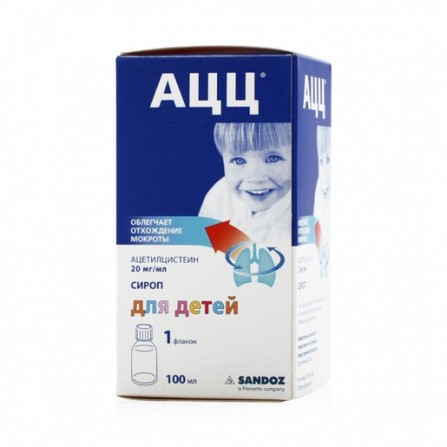More info
Active ingredients
Acetylcysteine
Release form
Syrup
Composition
The syrup is clear, colorless, slightly viscous, with a cherry smell. 1 ml of acetylcysteine 20 mg Auxiliary substances: methyl parahydroxybenzoate - 1.3 mg, sodium benzoate - 1.95 mg, disodium edetate - 1 mg, sodium saccharinate - 1 mg, carmellose sodium - 2 mg, sodium hydroxide (10% aqueous solution) - 30-70 mg , Cherry fragrance - 1.5 mg, purified water - 910.25-950.25 mg.
Pharmacological effect
Mucolytic drug. Acetylcysteine is a derivative of the amino acid cysteine. It has a mucolytic effect, facilitates sputum discharge due to a direct effect on the rheological properties of sputum. The action is due to the ability to break the disulfide bonds of the mucopolysaccharide chains and cause the depolymerization of the mucoproteins of sputum, which leads to a decrease in the viscosity of the sputum. The drug retains activity in the presence of purulent sputum. It has an antioxidant effect, due to the ability of its reactive sulfhydryl groups (SH-groups) to bind with oxidative radicals and, thus, neutralize them. In addition, acetylcysteine contributes to the synthesis of glutathione, an important component of the antioxidant system and chemical detoxification of the body. The antioxidant effect of acetylcysteine increases the protection of cells against the damaging effects of free radical oxidation, which is characteristic of an intense inflammatory reaction. With prophylactic use of acetylcysteine, a decrease in the frequency and severity of exacerbations in patients with chronic bronchitis and cystic fibrosis has been observed.
Indications
- respiratory diseases associated with the formation of viscous sputum difficult to separate (acute and chronic bronchitis, obstructive bronchitis, tracheitis, laryngotracheitis, pneumonia, lung abscess, bronchiectasis, bronchial asthma, COPD, bronchiolitis, cystic fibrosis). - acute and chronic sinusitis. - average otitis.
Use during pregnancy and lactation
Due to insufficient data, the use of the drug during pregnancy is contraindicated. For syrup: the use of the drug during pregnancy is possible only if the intended benefit to the mother outweighs the potential risk to the fetus. If necessary, the use of the drug during lactation should decide on the termination of breastfeeding.
Side effects
According to WHO, undesirable effects are classified according to their frequency of development as follows: very often (& # 8805 .1 / 10), often (& # 8805 .1 / 100, <1/10), infrequently (& # 8805 .1 / 1000, <1/100), rarely (& # 8805 .1 / 10 000, <1/1000) and very rarely (<10 000), the frequency is unknown (the frequency of occurrence cannot be determined on the basis of available data). Allergic reactions: infrequently - pruritus, rash, rash, urticaria, angioedema. very rarely - anaphylactic reactions up to shock, Stevens-Johnson syndrome, toxic epidermal necrolysis (Lyell's syndrome). On the part of the respiratory system: rarely - shortness of breath, bronchospasm (mainly in patients with bronchial hyperreactivity in bronchial asthma). Since the cardiovascular system: infrequently - lowering blood pressure, tachycardia. On the part of the digestive system: rarely - stomatitis, abdominal pain, nausea, vomiting, diarrhea, heartburn, dyspepsia. On the part of the organ of hearing: infrequently - tinnitus. Other: rarely - headache, fever. in isolated cases - the development of bleeding as a manifestation of hypersensitivity reactions, reduction of platelet aggregation.
special instructions
According to WHO, undesirable effects are classified according to their frequency of development as follows: very often (& # 8805 .1 / 10), often (& # 8805 .1 / 100, <1/10), infrequently (& # 8805 .1 / 1000, <1/100), rarely (& # 8805 .1 / 10 000, <1/1000) and very rarely (<10 000), the frequency is unknown (the frequency of occurrence cannot be determined on the basis of available data). Allergic reactions: infrequently - pruritus, rash, rash, urticaria, angioedema. very rarely - anaphylactic reactions up to shock, Stevens-Johnson syndrome, toxic epidermal necrolysis (Lyell's syndrome). On the part of the respiratory system: rarely - shortness of breath, bronchospasm (mainly in patients with bronchial hyperreactivity in bronchial asthma). Since the cardiovascular system: infrequently - lowering blood pressure, tachycardia. On the part of the digestive system: rarely - stomatitis, abdominal pain, nausea, vomiting, diarrhea, heartburn, dyspepsia. On the part of the organ of hearing: infrequently - tinnitus. Other: rarely - headache, fever. in isolated cases - the development of bleeding as a manifestation of hypersensitivity reactions, reduction of platelet aggregation.





